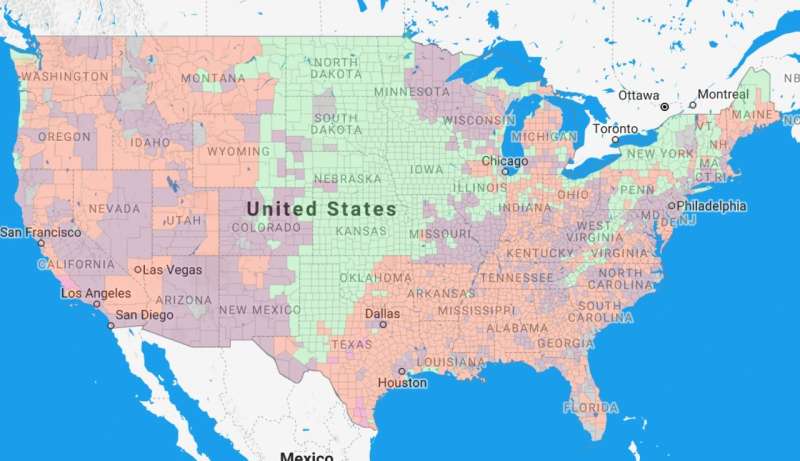Credit: University of Texas at Austin
Changing market conditions have made natural gas, wind and solar energy the lowest-cost technologies for new electricity generation for most of the U.S., according to updated research released today by The University of Texas at Austin's Energy Institute.
The research features a series of maps that have been revised to reflect shifting market conditions, a new policy environment and other factors affecting the cost of electricity generation in counties across the U.S. The updated version also displays the same data for congressional districts.
The original analyses supporting the maps is contained in a white paper titled "New U.S. Power Costs: by County, with Environmental Externalities." The paper is part of a comprehensive study coordinated by the Energy Institute, the "Full Cost of Electricity (FCe-)," initially issued in December 2016 and updated for today's release with additional research.
Researchers analyzed data for the most competitive sources of new electricity generation. Wind again proved to be the option with the lowest cost, on a levelized basis, for a broad swath of the country, from the High Plains, the Midwest and Texas, and even portions of the Northeast. Solar power is the cheapest technology in much of the Southwest, and, based on updated data, also in the eastern and northern regions of the U.S. Natural gas prevailed for much of the rest of the country.
Joshua Rhodes, a research affiliate at the Energy Institute and lead author of the paper, said the research assesses multiple generation technologies including coal, natural gas, solar, wind and nuclear. The maps released today feature updated prices for natural gas and renewables.
"The new maps present a more accurate reflection of current market conditions, including revised prices that indicate the cost of various generating technologies," Rhodes said.
Researchers examined existing studies to enhance a formula used to calculate generation costs known as the Levelized Cost of Electricity (LCOE). The formula factors in "externalities" such as the public health and environmental effects associated with electricity generation – which the LCOE formula typically does not include – to calculate truer costs for each generation technology.
The team also developed online calculators to facilitate a discussion among policymakers and others about the cost implications of policy actions associated with new electricity generation.
"We think our methodology is sound and hope it encourages constructive dialogue," Rhodes said. "To enable this dialogue among stakeholders who disagree about the various cost factors, we've created tools to allow them to change the factors and observe the outcomes."
For the FCe- study as a whole, researchers adopted a holistic approach to probe the key factors affecting the total direct and indirect costs of generating and delivering electricity. Their work resulted in the production of more than a dozen authoritative white papers that provide an in-depth assessment and examination of various electric power system options.
"These are complex, interrelated issues that warrant a cross-disciplinary examination," said Carey King, an assistant director at the Energy Institute and a principal investigator for the study.
"The research team we assembled reflects considerable depth of expertise on a wide range of disciplines including engineering, geosciences, business, public policy and law," he added.
The updated version of the study also contains several new white papers, including an analysis of how the integration of distributed energy resources such as rooftop solar onto the electric grid is disrupting the traditional utility business model. Graduate students participating in a research project directed by the Energy Institute as part of a Policy Research Project in UT's LBJ School of Public Affairs produced the paper, which assesses the efficacy of six new utility business models.
Another new paper explores the impact of financial support for electricity generation technologies. The report examines data from government and other sources to calculate a dollar-per-megawatt value of subsidies and their effect on technologies or fuels extensively used in power generation.
"The new papers contained in this updated version complete the picture," King said, noting that the tools researchers created allow customers to consider how various factors affect their electric bills.
"The LCOE calculator shows new power plant costs, but that accounts for only half of a customer's bill," King noted. "You can choose to include externalities, or exclude them. You then add the LCOE – with or without externalities – to the cost of operating the electric grid, plus subsidies that affect practically all energy technologies, to see how they affect the consumer."
For more about the FCe- study and for digests of the white papers, read the executive summary.
Provided by University of Texas at Austin























